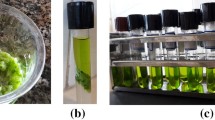Abstract
Residues of ethion were estimated in cucumber by gas liquid chromatography following three applications of the insecticide at 375 and 750 g a.i ha−1. The average initial deposits of ethion on cucumber fruits were found to be 2.40 and 4.97 mg kg−1 at single and double dosages, respectively. Residues of ethion dissipated below the maximum residue limit (MRL) of 0.5 mg kg−1 in 7 days. Half-life (T1/2) for degradation of ethion on cucumber was observed to be 2.92 days at recommended dosage. A waiting period of 7 days is suggested for safe consumption of cucumber.
Similar content being viewed by others
References
Anonymous (2004) Annual report: All India Network Project on Agricultural Acarology. Department of Entomology, Punjab Agricultural University, Ludhiana
Anonymous (2005) Package of practices for cultivation of vegetables, pp 13. Punjab Agricultural University, Ludhiana
Arora PK, Battu RS, Singh B (2004) Bioefficacy of ethion against mite Eutetranychus orientalis (Klein) and its residues on pear fruits. Pestic Res J 16(2):33–35
Braun HE, Ritcey GM, Frank R, McEwen FL, Ripley BD (1980) Dissipation rates of insecticide in six minor vegetable crops grown on organic soil in Ontario, Canada. Pestic Sci 11:605–616
Handa SK, Agnihotri NP, Kulshrestha G (1999) Maximum residue limits of pesticides. In: Handa SK, Agnihotri NP Kulshrestha G (eds.) Pesticide residues significance, management and analysis. Research Periodicals and Book Publishing House, Houston, pp 9–21
Hoskin WM (1961) Mathematical treatments of the rate of loss of pesticide residues. FAO Pl Prot Bull 9:163–168
Jyot G, Sahoo SK, Battu RS, Kang BK, Singh B (2005) Dissipation of ethion on brinjal (Solanum melongena L.) under subtropical conditions at Ludhiana, Punjab, India. Bull Environ Contam Toxicol 75:1094–1097
MacNeil JD, Hikichi M (1976) Degradation of endosulfan and ethion on pears and grape foliage. J Agric Food Chem 24:608–611
Acknowledgments
Authors thank the Professor and Head, Department of Entomology P.A.U Ludhiana for providing the necessary research facilities during the tenure of study.
Author information
Authors and Affiliations
Corresponding author
Rights and permissions
About this article
Cite this article
Singh, G., Singh, B., Battu, R.S. et al. Persistence of Ethion Residues on Cucumber, Cucumis sativus (Linn.) using Gas Chromatography with Nitrogen Phosphorus Detector. Bull Environ Contam Toxicol 79, 437–439 (2007). https://doi.org/10.1007/s00128-007-9251-2
Received:
Accepted:
Published:
Issue Date:
DOI: https://doi.org/10.1007/s00128-007-9251-2




